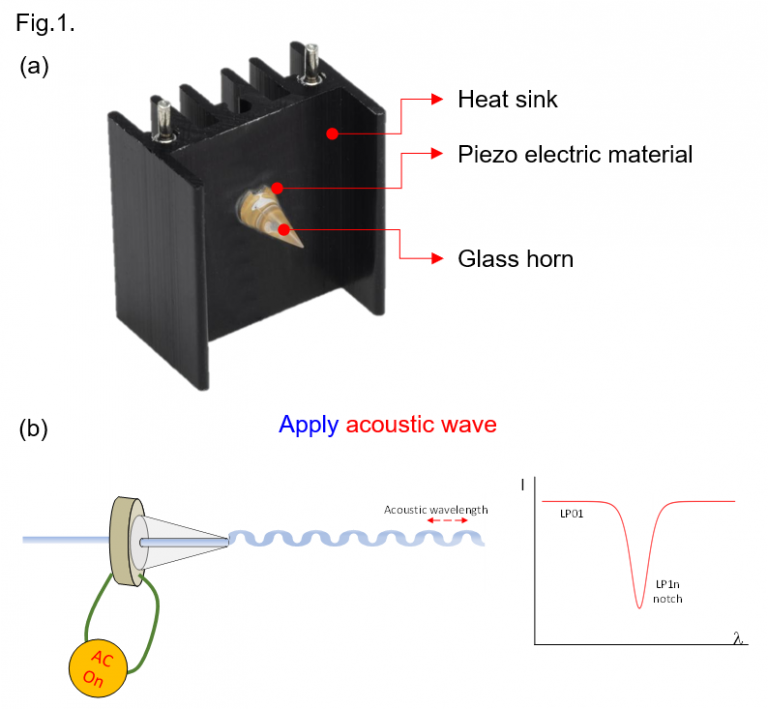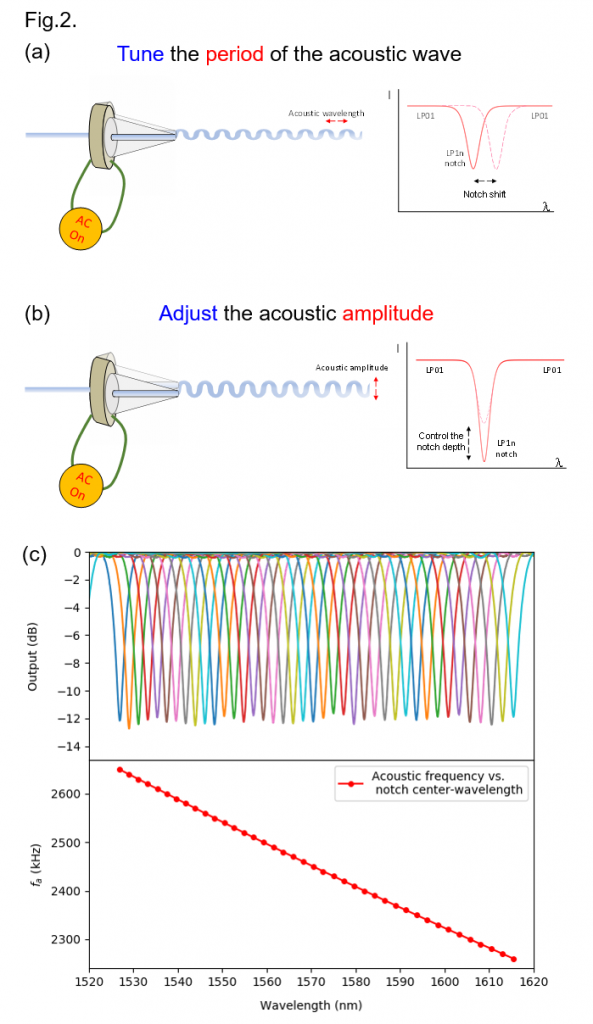All-fiber based acousto-optic tunable filter (AOTF) provides highly efficient notch filtering with practically no optical loss. Hundreds of periodic microbends induced by traveling acoustic wave in a single mode optical fiber produces a sharp notch filter (4 nm FWHM). By adjusting the frequency and the amplitude of the applied RF signal, the center wavelength and the notch depth of the filter can be tuned. When used in a few-mode fiber (FMF), the device can be operated as a frequency shifter or a mode converter.
Working Principle

Figure 1 shows (a) AOTF transducer and the scheme of the AOTF. High-precision glass horn has a hole at the center of the transducer and user can insert the 125 mm diameter optical fiber into the glass horn. This collinear-axis transducer provides high-efficient acoustic amplitude to the optical fiber and it is also reusable during the experiments. As shown in Fig.1(b), glass horn generates the flexural wave to the optical fiber and acoustic wave propagates along the optical fiber. Hundreds of asymmetric micro-bends induced by traveling acoustic wave creates a periodical long period gratings (LPG). The LPG formed by periodic perturbation produces the LP01 mode to the asymmetric higher order modes, for example, LP11, LP12, LP13 and so on. When the single-mode fiber is installed in the AOTF, the LP01 core mode couples to the antisymmetric cladding modes and these higher order modes is absorbed in the polymer jacket of the optical fiber. The 3-dB bandwidth is invers proportional to the number of the gratings and due to the hundreds of the gratings, 3-4 nm FWHM of the notch is generated using the AOTF.

Figure 2(a) and (b) show the function of the AOTF. When the grating period coincides with the beatlength, mode coupling from core mode to cladding mode takes place at specific wavelength.
The center wavelength of the notch depends on the acoustic period and by controlling the applied frequency and amplitude, the center wavelength and the depth of the notch can be tuned, respectively. Figure 2(c) shows center wavelength of the notch as a function of the applied acoustic frequency. As can be seen in the lower figure 2(c), the wavelength dependence of the applied frequency is almost linear in 1530-1610 nm wavelength region.
Demo Video
• High efficiency notch filtering
• All-fiber optic construction
• Low optical loss
• Custom operation wavelength range
• Electronically control of center wavelength and notch depth
.png)
The AOTFs have been installed, followed by diverse applications as gain flattening filter, notch filter, mode-locked fiber laser, swept laser, and so on. When used in a few-mode fiber (FMF), the device can be operated as a frequency shifter or a higher-order mode converter.
Two types for the ATOF is available depends on the end user’s experimental purpose. One is Packaged type and the other one is a module for the research. For the filter application, packaged type would be suggested. For the module type, user can install the 125 mm diameter optical fiber to the apparatus by themselves.
The module type, the end of the glass horn is extremely sharp and easy to fragile, therefore it requires the user’s careful discretion. AOTF-A2 needs skills for handling and we recommend this module for the end-user who has experience with the AOTF module.
• Spectral notch filter
• Frequency shifter
• Spectral shaper